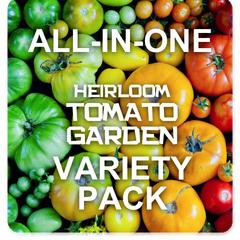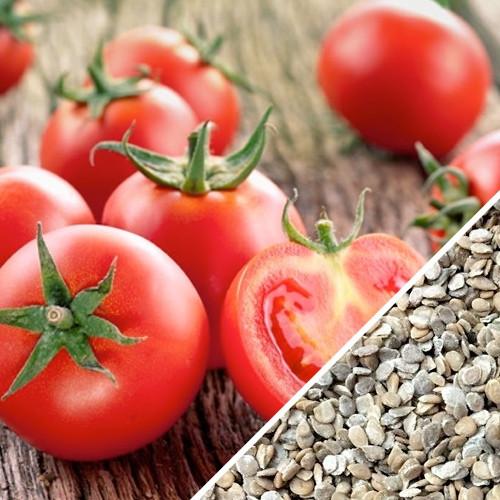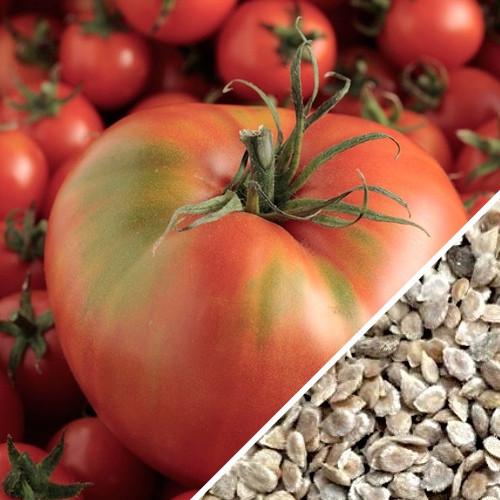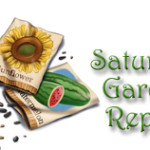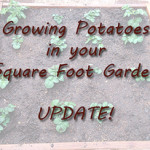Growing tomatoes at home is a great for beginning and veteran gardeners. There are so many ways to successfully grow tomatoes that it may be the perfect first food to grow! I’m going to share everything I know about growing tomatoes to help you get started or to have bigger and better harvests.
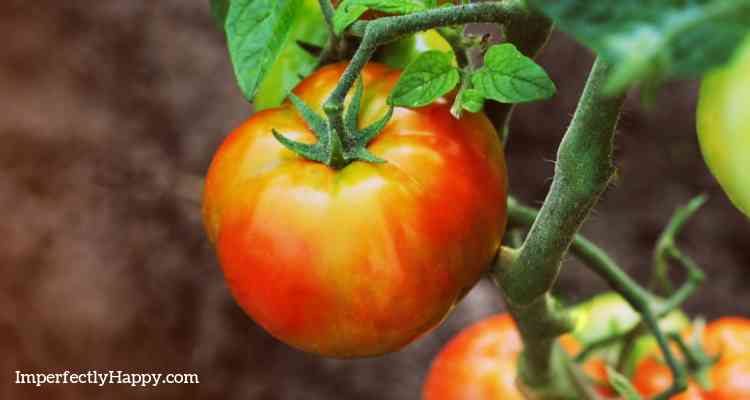
Growing Tomatoes At Home
Once you start growing tomatoes at home and taste the rich flavor, you’ll never want a store-bought tomato again. And don’t just limit yourself to the standard red beef steak – there are a rainbow of tomato colors and flavors that await you. Grow them outdoors in bed, in boxes, in pots…you can even grow some tomatoes indoors. You’re going to love your homegrown tomatoes!
How to grow healthy tomatoes.
Growing tomatoes, healthy tomatoes, comes down to a few basics.
- Seeds
- Season
- Soil
- Light
- Water
- Pruning
Tomato Seeds – What You Need to Know
Growing tomatoes takes a good quality seed is the start to a great tomato garden! There are so many tomato varieties to choose from! Some people prefer to grow heirloom tomatoes for their flavor and history others prefer a hybrid (which is NOT GMO necessarily) for their vigor. I recommend trying a few of each to see how well they do in your area and garden.
What is an heirloom tomato?
According to Wikipedia, “An heirloom tomato is an open-pollinated (non-hybrid) heirloom cultivar of tomato. An heirloom tomato is usually a variety that has been around for generations and cultivated for its unique characteristics…heirlooms have history.
I do think it is important to grow heirloom tomatoes but you’ll need to find one that does well in your climate.
What is a hybrid tomato?
Simply put a hybrid tomato is a purposeful cross-pollination of two varieties for tomatoes. The end-goal is to produce a tomato with the best traits of both varieties. This could be bigger fruit, more heat or pest resistant, early maturity and plant size can also be factored it. Hybrids are not genetically modified or GMO and do not need to be feared.
What Do Determinate and Indeterminate Tomato Varieties Mean?
All tomatoes are either determinate or indeterminate.
A determinate tomato will reach a “determined” plant height and will not grow higher. These tomato plants will produce fruit in 1 – 2 months, at the end of their branches. Great for canning and sauces because most of the tomatoes will be ripe and ready to harvest at one time. Check out Ace 55.
An indeterminate tomato plant will grow to an undetermined size, especially if not pruned. They can grow over 5 feet tall fruit throughout the growing season. These varieties are generally trellised but I have had HUGE tomato plants that I left to their own devices that filled up a 4×4 box (and gave me lots of fruit). Check out The Mortgage Lifter.
Where can I buy tomato seeds online?
I buy most of my tomato seeds from Seeds Now. They are a small, family owned, company that offers quality organic, non-gmo, seeds.
You can see more about seed catalogs here!
Can I grow tomato plants from seeds completely outdoors?
You can if you live in a warmer climate. But even here in Phoenix, I prefer to start my tomatoes indoors and transplant them to my garden.
When is the best time to plant tomatoes? When growing tomatoes in most areas you’re going to want to start your seeds indoors 4 to 6 weeks before your area’s last frost of spring. How long do tomato seeds take to germinate? Tomato seeds will germinate in 7 to 14 days when started indoors. You can transplant them to your garden, raised beds or pots when the soil is warm.
How to plant tomato seeds.
When growing tomatoes from seed you’ll want to plant your tomato seeds in potting soil (see more on soil below). The seeds should be planted about a 1/4 inch deep in seedling pots that are 3 – 4 inches in depth so they have room to grow. Keep the indoor seedlings in a warm, ventilated area, with plenty of light. Be sure to keep the soil moist, but not overly wet which can cause fungus.
Frugal DIY Starter Pots
How to Use Seeds and Transplants in Your Garden
What’s a good soil mixture for tomato seedling transplants?
Let’s talk soil for growing tomatoes! Tomatoes are heavy feeders and the soil you plant them in will effect their flavor. I recommend a rich soil, amended with plenty of compost. Tomatoes do prefer a slightly more acidic soil but if you focus on richness you should have great plants and big harvests.
Other than good organic compost you may want to consider these amendments:
Alfalfa meal
Blood meal
Fish meal
Leaf mold (how to make leaf mold)
Bone Meal
Worm Castings (consider growing your own – Worm Factory Kit )
I’ve had good luck with my DIY Soil Mix.
Where to plant tomatoes.
You’ll plant your tomatoes in a sunny spot where they have access to sunlight for 6 to 8 hours a day. Morning sun is best because too much heat can actually burn your tomatoes (a big consideration in climates like Phoenix).
Plant with growing in mind. I plant mine in 4 x 4 raised beds, 1 plant per bed. If planting directly in the ground give them 48 inches of space.
Watering tomato plants.
When growing tomatoes you want to keep the soil moist but down drown them. Over watering or inconsistent watering can cause the tomatoes to split or develop blossom end rot.
Can tomatoes be grown in a pot?
Yes they can, and very successfully. I love growing tomatoes in fabric pots that will keep your plants for getting root rot.
For determinate tomatoes you’ll want a container that is at least 18 inches in diameter and 24 inches for your indeterminate tomatoes.
Follow the same guidelines for soil, water and sun.
What are tips and hacks to growing tomatoes?
Every gardener has their own tips and hacks for growing tomatoes. Here are a few for you to consider and try in your own garden.
- Use eggshells – Adding shells to your soil before planting can give your plants a calcium boost while growing. Which can help prevent blossom end rot. More uses for eggshells.
- Coffee grounds – Mixing some coffee grounds into your soil can help to repel snails and slugs; as well as adding some nitrogen into your soil. More ways to recycle coffee grounds.
- Epsom Salt – great if soil test shows you soil lacks magnesium. More uses for Epsom salt.
- Mulching – mulching around your growing tomatoes will help to conserve water, prevent weeds and keep the soil warm.
- Offer support – Growing tomatoes need the support of stakes, cages or trellises.
How long does it take a tomato plant to grow?
This is a harder question to answer because things like variety, area, etc will effect that. But when growing tomatoes you 2 to 3 months of growth before you’ll be able to harvest anything, shorter for cherry-type varieties.
Common Tomato Pests and Disease
Tomatoes are a great beginner plant because they are generally easier to grow than many other fruits and vegetables. But they can suffer from blossom end rot, early and late blight and many other diseases. Most of these can be prevented with crop rotation, companion planting, and following good water practices.
Horn worms, aphids and white flies are just a few of the pests that you can face when growing tomatoes.
See: Controlling Aphids Naturally and more on Tomato Pests.
Pinching and Pruning Tomato Plants
I have often let me tomato plants grow naturally without pruning or pinching of any kind. But the school of thought is pinching off the suckers that sprout up in the middle of two branches, can help your plants use nutrients and energy more efficiently. By pruning your tomato plant’s yellowing leaves you give the overall health of your growing tomatoes a boost.
When to harvest tomatoes
Growing tomatoes means harvesting when the fruit is firm to the touch but has a bit of give to it. Fruit that is ready to be picked should pull way easily from the vine. A tomato will tek up to 8 weeks to ripen on determinate plants and up to 12 weeks on indeterminate plants.
How to store tomatoes
Your homegrown tomatoes should be stored at room temperature, though in warmer climates the refrigerator might be better. If it is too warm the fruit will continue to ripen and rot.
Try making tomato powder out of your extra tomatoes. Or freeze or can your tomatoes for later use.
